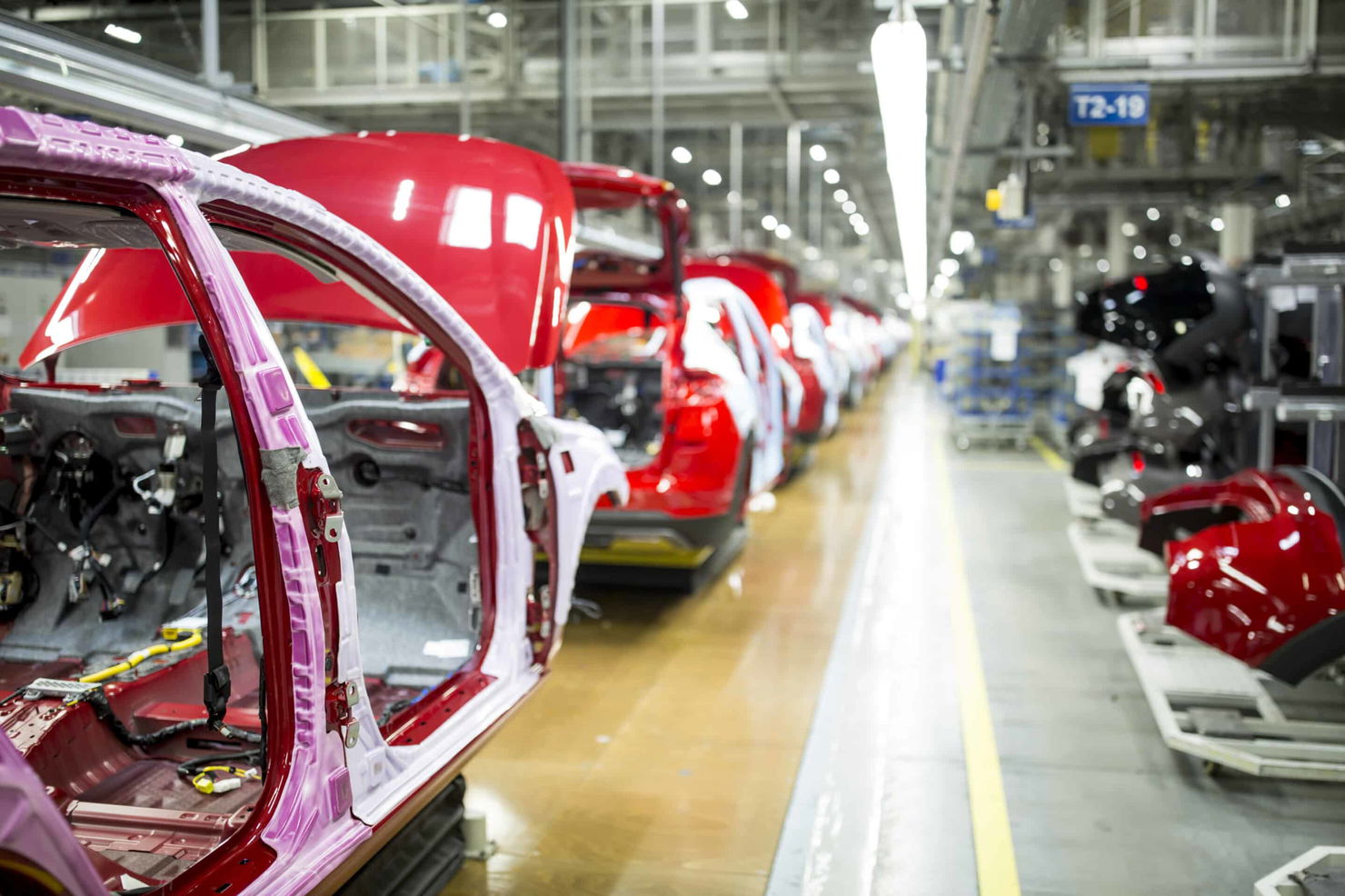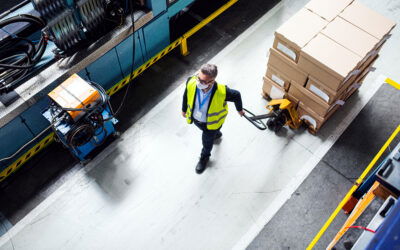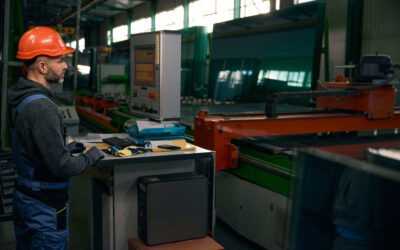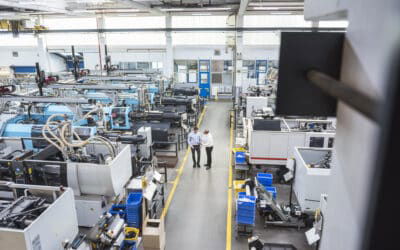OEE (Overall Equipment Effectiveness) is the benchmark indicator for measuring the performance of automotive production equipment. Industrial monitoring transforms OEE management by automating data collection and eliminating manual reporting. In mechanical parts manufacturing, every OEE point gained represents considerable financial gains. Find out how modern monitoring solutions can improve OEE and decision-making in the automotive industry.
What is OEE in the automotive industry?
OEE (Overall Equipment Effectiveness) measures the actual utilization rate of a machine in relation to its theoretical capacity. This indicator is calculated by multiplying three components: OEE = Availability × Performance × Quality.
In automotive parts manufacturing, OEE reveals the hidden losses in the production process. A machine with an OEE of 65% actually produces only 10.4 hours out of 16 planned hours. The automotive industry targets an OEE of 85%, but many plants operate between 60% and 75%.
Financial impact of OEE
1 OEE point saved = €100,000 to €300,000 per year, depending on the size of the plant. On a plant scale, 5 OEE points represent several million euros.
The six major losses impacting OEE: unplanned breakdowns, adjustments and series changes, microstops, reduced speeds, start-up faults and production faults.
Supervision and Monitoring System: The Key to Improving OEE
A supervision system connects machines via the industrial network to collect, analyze and visualize data in real time. This approach transforms operations by automating the acquisition of performance indicators.
Components of Effective Supervision Software
Automatic acquisition: machine status, cycle times, causes of stoppages, production quantities via industrial network, compatible with all equipment.
Data visualization: Screens in workshops and control rooms displaying performance indicators (OEE, availability, quality) with color codes and alarms.
Management software: automatic OEE calculation, automated reporting, Pareto data analysis, ERP/MES exports.
Security: Data protection, full traceability, regulatory compliance.
Obstacles to Automotive OEE Optimization
Manual reporting and heterogeneous machinery
The main obstacle remains time-consuming and inaccurate manual reporting. Automotive plants group together a variety of equipment (CNC, lathes, grinders, presses) on each production line. Many older machines offer limited connectivity. Cabinets often cannot be opened to avoid engineering validation and weeks of implementation. Investment criteria are strict, with precise specifications.
Case Study: 90 Connected Machines in a French Automotive Plant
An Automotive Leader Faced with Digitization
A major French automotive manufacturer, world leader with several parts manufacturing and assembly plants, has set up an industrial monitoring system to improve OEE and gain in competitiveness in the face of international competition.
Objectives and specifications
In its “mechanical” plants manufacturing discrete parts (crankshafts, camshafts, connecting rods), the company wanted to connect machines to automate data acquisition, eliminate manual reporting, accurately monitor performance and understand the causes of losses.
Four major challenges:
- The machine park is diversified and the production stages are very different in nature
- Many machines are old and offer limited connectivity
- To avoid engineering validation and several weeks of implementation by an external entity, the cabinets cannot be opened.
- Strict investment criteria
TEEPTRAk solution: Industrial Monitoring PerfTrak and MoniTrak
PerfTrak technology was chosen for its universal compatibility and non-intrusive approach.
Impressive deployment:
- 90 machines connected to the network in just a few weeks
- Automated identification of downtime and causes of downtime
- 40 real-time supervision screens (MoniTrak systems)
- Data visualization in control rooms and workshops
- Performance drift alarms
Teams were trained by TEEPTRAk over three days, enabling local teams to deploy and configure the rest in complete autonomy.
Results: ROI less than 1 year
Time savings: Automation of OEE collection and calculation, freeing up valuable time.
Reallocation of resources: Operators have been reassigned to improvement actions rather than time-consuming reporting tasks. They concentrate on data analysis, problem solving and production process optimization.
Team commitment: Operators, empowered by the daily use of connected objects, are involved in continuous improvement. The company carries out its digitalization in a healthy, sustainable environment.
“PerfTrak systems are already paying for themselves given the time freed up for operators, who are now focused on value-added tasks rather than data collection and report preparation.”
Christophe Pasquet, Monozukuri, PRF (Costing), Usine du Futur, PSA Caen
TEEPTRAk Supervision Solutions for the Automotive Industry
PerfTrak: Intrusion-free monitoring
PerfTrak connects any automotive machine without opening cabinets: non-intrusive installation on existing networks, compatibility with all equipment, automatic status acquisition, real-time OEE calculation with data security.
MoniTrak: Visualization and Monitoring
MoniTrak offers data visualization for all: supervision screens in workshops and control rooms, real-time performance indicators, intelligent alarms, continuous OEE monitoring.
Automotive Production Applications
Machining of engine parts (crankshafts, camshafts), transmission production (gears, differentials), chassis production (suspension arms), heat treatment and finishing on all production lines.
Deploying an Industrial Monitoring System
Defining specifications
Current and target OEE, technical constraints, budget and expected ROI, data protection and security requirements.
Choosing Supervisory Solutions
Select a system with existing machine park compatibility, no need to open cabinets, automatic network acquisition, real-time OEE calculation, data protection and rapid implementation.
Start with a Pilot
Test on a pilot production line, validate OEE gains and ROI, gradually extend to the entire operation.
Training for Autonomy
Train operators and technicians in data visualization, data analysis and alarm processing for informed decision-making.
FAQ – Frequently asked questions about OEE and Automotive Industrial Monitoring
What is OEE in the automotive industry?
OEE (Overall Equipment Effectiveness ) is the key indicator that measures the overall efficiency of automotive production equipment. It is calculated by multiplying three components: Availability × Performance × Quality. In mechanical parts manufacturing, an OEE of 85% is considered excellent, but most plants operate between 60% and 75%.
How do you calculate the OEE of an automotive production machine?
The OEE is calculated as follows:
- Availability = Actual production time / Planned production time
- Performance = Actual speed / Theoretical speed
- Quality = Good parts / Total parts produced
- OEE = Availability × Performance × Quality × 100
Modern supervision software automatically calculates the OEE in real time by acquiring data from the industrial network.
What is industrial monitoring?
Industrial monitoring is a supervision system that connects production machines via the network to collect, analyze and visualize data in real time. It automates the identification of downtime and causes, eliminates manual reporting and improves decision-making by visualizing data in the control room and on the shop floor.
Can older machines be connected without opening the electrical cabinets?
Yes, modern solutions like PerfTrak can connect older machines with limited connectivity without opening the cabinets. This non-intrusive approach avoids engineering validation and several weeks of implementation. Compatibility is assured with all types of automotive production equipment.
What is the ROI of an automotive industrial monitoring system?
Typical ROI is between 6 and 18 months. In the case of the French automotive plant (PSA Caen) presented in this article, the ROI was less than 1 year. Gains came from eliminating manual reporting, improving OEE (each point = €100,000 to €300,000/year), and reassigning operators to value-added tasks.
What are the main causes of OEE loss in the automotive industry?
The six major losses impacting OEE in automotive parts manufacturing are :
- Breakdowns and unplanned stoppages
- Series settings and changes
- Microstops and slowdowns
- Reduced speeds
- Starting faults
- Production defects (scrap and rework)
High-performance management software automatically identifies these causes through data analysis.
How long does it take to deploy industrial monitoring?
With an adapted solution like TEEPTRAk, deployment is rapid: 90 machines can be connected in just a few weeks. Installation requires no opening of cabinets, thus avoiding several weeks of implementation by an external entity. A 3-day training course enables teams to operate and extend the system independently.
Conclusion: Industrial Monitoring as an Automotive Performance Lever
OEE is a strategic lever for automotive parts manufacturers. With the right supervision software, the results are immediate: 90 machines connected in just a few weeks, elimination of manual reporting, ROI of less than 1 year.
The three pillars: automatic supervision system with network acquisition, real-time visualization in the control room, data protection and team autonomy.
Discover TEEPTRAK: industrial monitoring that connects 90 machines in just a few weeks, with universal compatibility, automatic acquisition, advanced data analysis, intelligent alarms and proven ROI. The solution for optimizing your automotive OEE with security, ease of implementation and high-performance operation of every production line.





0 Comments